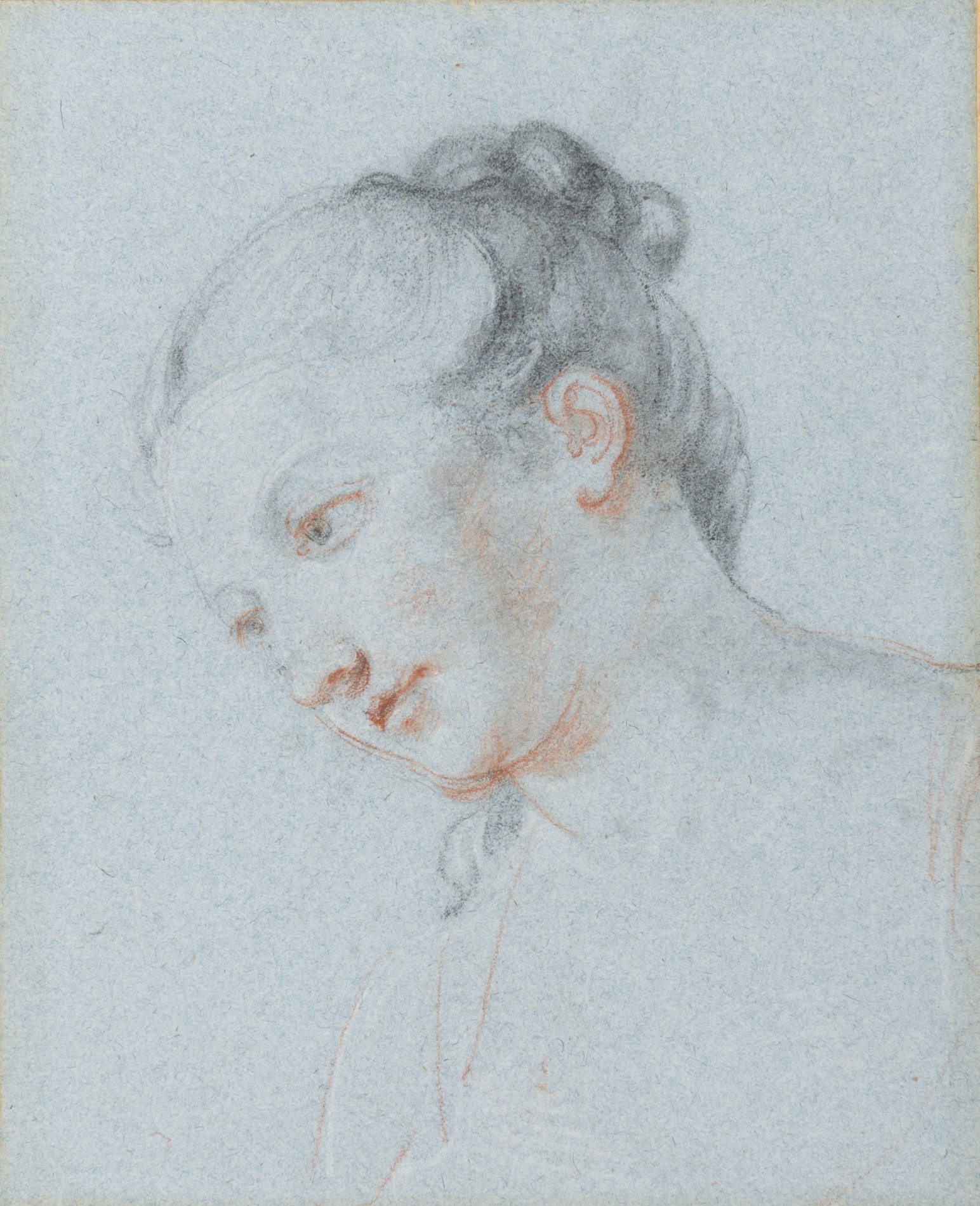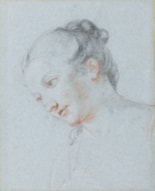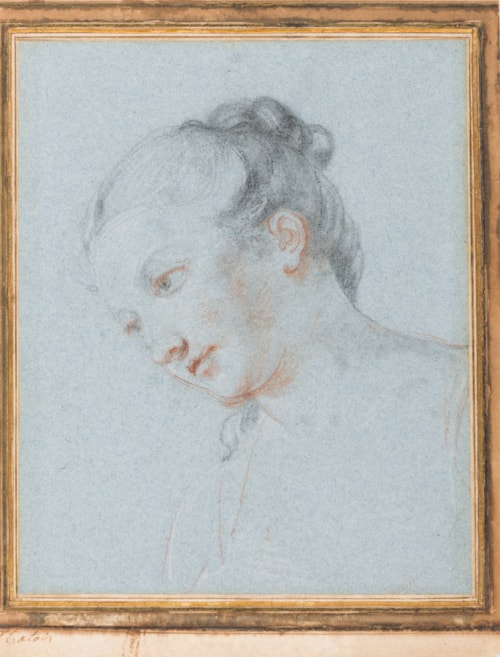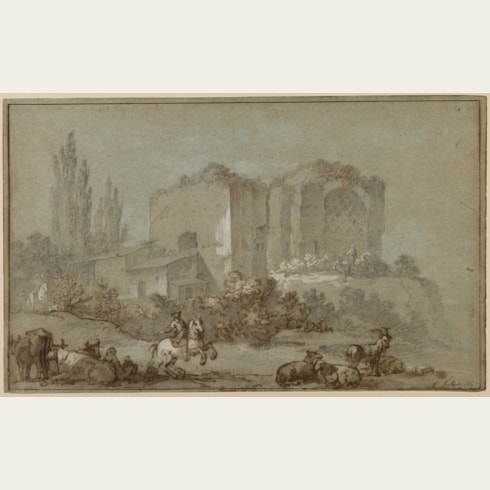Charles-Joseph NATOIRE
(Nîmes 1700 - Castel Gandolfo 1777)
The Head of a Young Woman
Sold
Black, red and white chalk on blue paper.
Laid down on part of a 18th century mount.
Inscribed Natoir on the old mount.
225 x 185 mm. (8 7/8 x 7 1/4 in.)
Laid down on part of a 18th century mount.
Inscribed Natoir on the old mount.
225 x 185 mm. (8 7/8 x 7 1/4 in.)
Delicately drawn in a combination of black, red and white chalks on blue paper, the present sheet depicts a type of female head that is found throughout Charles-Joseph Natoire’s oeuvre as a painter. It would in particular appear to be a preparatory study for the head of a woman riding a donkey in his painting of Travellers Resting by a Fountain, one of a pair of large canvases executed in 1737 for the dining room of Louis XV’s petits appartements at the Château of Fontainebleau, and today in a private collection. The painting was one of a set of six canvases commissioned from Natoire for the King’s private apartments at Fontainebleau, where they remained until 1792. (Lost after the French Revolution, the paintings were only rediscovered some two hundred years later.) A closely-related painting of the same composition of Travellers Resting by a Fountain by Natoire, but horizontal in orientation, is in the Hood Museum of Art at Dartmouth College in Hanover, New Hampshire.
The only other known preparatory drawing by Natoire for the Travellers Resting by a Fountain is a red chalk study of the entire figure of the woman seated on a donkey, in the Staatsgalerie in Stuttgart. Among stylistically and technically comparable studies by Natoire are drawings of female heads in the collections of the Louvre and the Musée Fabre in Montpellier.
This drawing by Natoire once belonged to the little-known 18th century Parisian architect Claude-Guillaume Debesse (d. before 1786), who is recorded as living on the rue du Chantre in Paris by 1747. A good friend of the engraver Johann Georg Wille, who mentions him a number of times in his posthumously-published memoirs, and also dedicated an engraving to him in 1774, Debesse seems to have been an avid collector of drawings. (He is said to have sold several paintings at auction, so as to devote himself entirely to collecting drawings.) Both Debesse and Wille acquired drawings from the posthumous sale of the collection of the painter François Boucher in 1771, and Debesse is also thought to have made purchases at the sales of the collectors Armand-Frédéric-Ernest Nogaret in 1778 and Antoine-Joseph Dézallier d’Argenville and the Marquis de Calvière in 1779. In January 1786, following Debesse’s death, his collection was dispersed at auction in Paris. Fifty drawings bearing his collector’s mark are today in the Louvre, while other examples are in the Art Institute of Chicago and the Detroit Institute of Arts.
The only other known preparatory drawing by Natoire for the Travellers Resting by a Fountain is a red chalk study of the entire figure of the woman seated on a donkey, in the Staatsgalerie in Stuttgart. Among stylistically and technically comparable studies by Natoire are drawings of female heads in the collections of the Louvre and the Musée Fabre in Montpellier.
This drawing by Natoire once belonged to the little-known 18th century Parisian architect Claude-Guillaume Debesse (d. before 1786), who is recorded as living on the rue du Chantre in Paris by 1747. A good friend of the engraver Johann Georg Wille, who mentions him a number of times in his posthumously-published memoirs, and also dedicated an engraving to him in 1774, Debesse seems to have been an avid collector of drawings. (He is said to have sold several paintings at auction, so as to devote himself entirely to collecting drawings.) Both Debesse and Wille acquired drawings from the posthumous sale of the collection of the painter François Boucher in 1771, and Debesse is also thought to have made purchases at the sales of the collectors Armand-Frédéric-Ernest Nogaret in 1778 and Antoine-Joseph Dézallier d’Argenville and the Marquis de Calvière in 1779. In January 1786, following Debesse’s death, his collection was dispersed at auction in Paris. Fifty drawings bearing his collector’s mark are today in the Louvre, while other examples are in the Art Institute of Chicago and the Detroit Institute of Arts.
Charles-Joseph Natoire studied with his father before entering the Parisian studio of Louis Galloche at the age of sixteen, transferring after three years to the atelier of François Le Moyne. Winning the Prix de Rome in 1721, he arrived in Rome two years later, and lived as a pensionnaire at the Académie de France until 1728, also winning a first prize in a competition at the Accademia di San Luca. After a period of time spent travelling around northern Italy, Natoire returned to France in 1730, when he was admitted into the Académie Royale as an associate member, rising to full membership in 1734.
During the 1730s and 1740s he was much in demand as a painter, earning a number of significant Royal, public and private commissions. Among his most important works were a series of paintings for the château of La Chapelle-Godefroy in Champagne, executed between 1731 and 1738. He also joined François Boucher and Carle van Loo in the decoration of the Hôtel de Soubise, on which he worked at the end of the 1730s. Natoire received royal commissions for work at Fontainebleau, Versailles and Marly, as well as for designs for Beauvais and Gobelins tapestries. Appointed director of the Académie de France in Rome in 1751, he was to remain in Italy for the rest of his life. Between 1754 and 1756 he designed a fresco of The Apotheosis of Saint Louis for the vault of the nave of the French national church in Rome, San Luigi dei Francesi. Natoire painted relatively little during the 1760s, however, and much of his later Roman years were spent drawing. He encouraged the pensionnaires at the Académie to draw directly from nature, and himself produced a number of finished landscape drawings which were to have a particular influence on two of his young students, Jean-Honoré Fragonard and Hubert Robert.
During the 1730s and 1740s he was much in demand as a painter, earning a number of significant Royal, public and private commissions. Among his most important works were a series of paintings for the château of La Chapelle-Godefroy in Champagne, executed between 1731 and 1738. He also joined François Boucher and Carle van Loo in the decoration of the Hôtel de Soubise, on which he worked at the end of the 1730s. Natoire received royal commissions for work at Fontainebleau, Versailles and Marly, as well as for designs for Beauvais and Gobelins tapestries. Appointed director of the Académie de France in Rome in 1751, he was to remain in Italy for the rest of his life. Between 1754 and 1756 he designed a fresco of The Apotheosis of Saint Louis for the vault of the nave of the French national church in Rome, San Luigi dei Francesi. Natoire painted relatively little during the 1760s, however, and much of his later Roman years were spent drawing. He encouraged the pensionnaires at the Académie to draw directly from nature, and himself produced a number of finished landscape drawings which were to have a particular influence on two of his young students, Jean-Honoré Fragonard and Hubert Robert.
Provenance
Probably the posthumous vente Natoire, Paris, Hôtel d’Aligre, 14 December 1778 onwards
Claude-Guillaume Debesse, Paris (Lugt 729), his paraphe on the verso
His posthumous sale, Paris, Hôtel de Bullion [Paillet], 12 January 1786, lot 38 or 236.
Claude-Guillaume Debesse, Paris (Lugt 729), his paraphe on the verso
His posthumous sale, Paris, Hôtel de Bullion [Paillet], 12 January 1786, lot 38 or 236.






